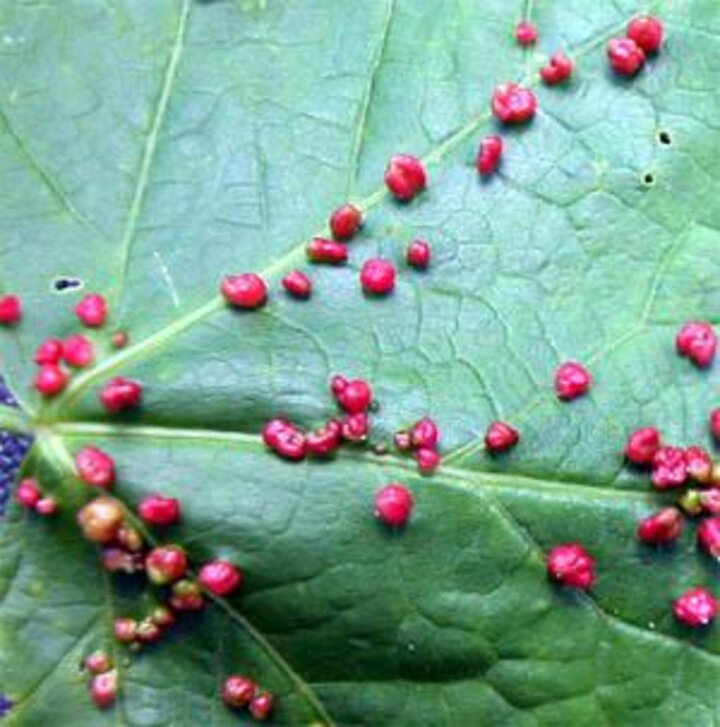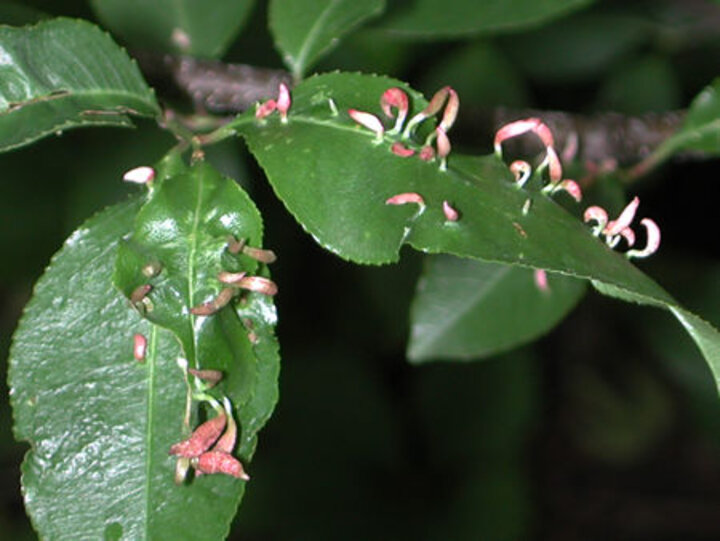Sarah Browning, Extension Educator
Hackberry Nipple Gall, Sarah Browning, Nebraska Extension
Each year in late spring and early summer, homeowners begin noticing strange growths on the leaves or stems and are concerned for the health of their trees. Several different types of galls are common on Nebraska trees, caused by the feeding or egg laying activities of insects or mites. Either the physical damage done by the insect or its salivary secretions as it feeds causes the plant to increase its production of plant hormones. These plant hormones cause abnormally increased plant growth in small, localized areas and result in the formation of a gall.
Homeowners often become quite alarmed when they discover their tree is developing galls. They fear the tree is going to die unless something is done quickly, but this is not the case. Leaf galls seldom, if ever, cause permanent injury to a tree, although they do detract from the trees’ beauty.
Once galls have formed there is no way to get rid of them and preventing galls is very difficult. So considering the negligible amount of impact they have on the tree, control is not recommended or necessary.
Maple Galls

One of the most common galls found in landscape trees is Maple bladder gall, caused by a mite that overwinters on the bark of maple trees, particularly Silver Maple. The wart-like galls are formed by the plant in response to mite feeding on the leaves as they emerge from the bud in early spring. Initially the galls are green, but change to red and finally to black as they mature. Leaves frequently become so covered with galls that they completely twist out of shape and may even drop early. Although the galls are ugly, maple leaf galls seldom, if ever, cause permanent damage to trees.
Maple spindle gall is common on Sugar Maple. This gall appears as a thin, almost worm-like structure that grows up from the upper surface of the leaf. The galls rarely distort the leaf but considerable number of galls can make the leaves unsightly.

Other Common Galls
Ash flower galls are clusters of black structures attached to the tips of branches, caused by tiny eriophyid mites that feed in the male flower clusters. The black clusters persist until the year following their development then fall from the tree. They are unsightly, but do not affect tree health.
It’s uncommon to find a hackberry tree not infected by hackberry nipple gall, caused by a tiny insect called a psyllid. This gall forms on the underside of the leaf and resembles a round green pouch.
Hackberries can also develop witches’ broom galls, caused by an eriophyid mite. A witches’ broom is an abnormal cluster of small twigs occuring at random throughout the tree.
Oaks are susceptible to many different galls, most of which are not serious. Oak blister gall and oak apple gall are common on oak leaves. However, oaks can also develop stem galls, such as oak bullet gall, which in high numbers may reduce plant growth.
Oak bullet gall, which affects primarily bur and swamp white oaks, develops as circular woody growths that often occur in masses along the stems. There appears to be some genetic differences between trees within a species, so that about 20% of bur and swamp white oak trees can have very high levels of infestation. The growth rate of heavily infected trees may be reduced.
Galls can even be found on evergreen trees, including eastern spruce gall and Cooley spruce gall.
More Information
Insect and Mite Galls, University of Minnesota Extension.
Images:
- Hackberry Nipple Gall. Image by Sarah Browning, Nebraska Extension
- Spindle Gall on Prunus. Image by Jeff Hahn, University of Minnesota Extension
- Maple Bladder Gall. Image from University of Kentucky Entomology
Search Our Archive
Associated Video
Galls
Nebraska Extension Urban Entomologist Jody Green talks about galls, what causes them and if there is anything you can do about them. May 30, 2021<br />
<br />